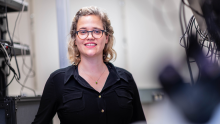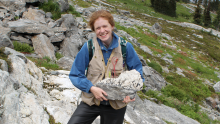A researcher is found dead hunched over her lab bench, and seven suspects are in custody. Now it’s up to 30 high school students to determine who killed her.
That’s the premise for an innovative science outreach program hosted by the Graduate Student Association (GSA) at UBC’s Life Sciences Institute (LSI). The one-day, hands-on lab is aimed at grade ten, eleven and twelve students in the hopes of sparking their interest in science as a career.
As a UBC graduate student Caylib Durand, along with post-doctoral fellow Santiago Ramon-Garcia and the first Executive Committee of the LSI-GSA, saw an opportunity to invite students to participate in a fun and interesting event that would afford them an inside look at a professional and active scientific environment.
Now in its third year, the outreach event was initially designed as part of Celebrate Research, a week-long UBC event that highlights key areas of research taking place on campus.
“There is so much incredible research happening at the Life Sciences Institute, but there’s limited public access,” says Durand. “We felt we had a unique opportunity to give back to the community through education.”
“Our goal was to give students hands-on training, mentorship, and an opportunity to experience and ask questions about research as a possible career choice.”
Durand, Santiago and fellow graduate students based the lab on the popular Crime Scene Investigation (CSI) television show, dubbing it “CSI at the LSI”. They scripted their own murder mystery, providing students with a list of suspects complete with mug shots, motives, and analysis of prepared evidence samples of blood, saliva, hair and skin.
“We wanted to introduce students to basic science techniques in an entertaining and interactive way,” says Santiago. “We came up with a pretty elaborate story line, but it allows students to have fun with it.”
The program’s methodology was published in the December issue of the Journal of Microbiology and Biology Education’s Tips and Tools segment.
The latest class of crime busters to tour the facility, made up of grade ten and eleven students from Eric Hamber Secondary School in Vancouver, was given an orientation on the Institute’s safety procedures. Graduate students and post-docs then set the scene: a female graduate student has been found dead at her bench, and the students must use basic scientific techniques to test evidence collected from the scene and find her killer.
The students were broken up into four groups and assigned a workshop where one of four samples was evaluated, using DNA analysis, protein analysis, fluorescence imaging techniques, or classical microbiology procedures. They were also given tours of the mass spectroscopy and electron microscopy facilities.
After completing their workshop module, students reconvened to share their results and use deductive reasoning to rule out suspects one-by-one.
“We wanted all of the students to get the chance to participate in the experiments,” says Santiago. “It’s great to see them collaborate and share what they’ve learned.”
“At the end of the day, the students gather to use the results from the workshops to determine the killer. We bring the killer into the lab, and when the students make their announcement, a security guard comes and takes them away. It’s a really fun way to get students interested in science.”
Students and teacher take home worksheets and a memory stick of materials, so they’re able to revisit and build on what they’ve learned during their time in the various work-shop labs.
Durand and Ramon-Garcia say that the program is just as popular with the grad students and post-docs as it is with its high school participants.
“When we started this program three years ago, we had no idea it would take off like it has,” says Durand. “Now we wish we could invite more students or host more events.”
“It’s a rewarding experience. Maybe more rewarding for us than it is for them!”
View the paper in the Journal of Microbiology and Biology Education
The Use of Popular Fiction to Present a Professional Scientific Career to High School Students
Musqueam First Nation land acknowledegement
We honour xwməθkwəy̓ əm (Musqueam) on whose ancestral, unceded territory UBC Vancouver is situated. UBC Science is committed to building meaningful relationships with Indigenous peoples so we can advance Reconciliation and ensure traditional ways of knowing enrich our teaching and research.
Learn more: Musqueam First Nation
Faculty of Science
Office of the Dean, Earth Sciences Building2178–2207 Main Mall
Vancouver, BC Canada
V6T 1Z4


